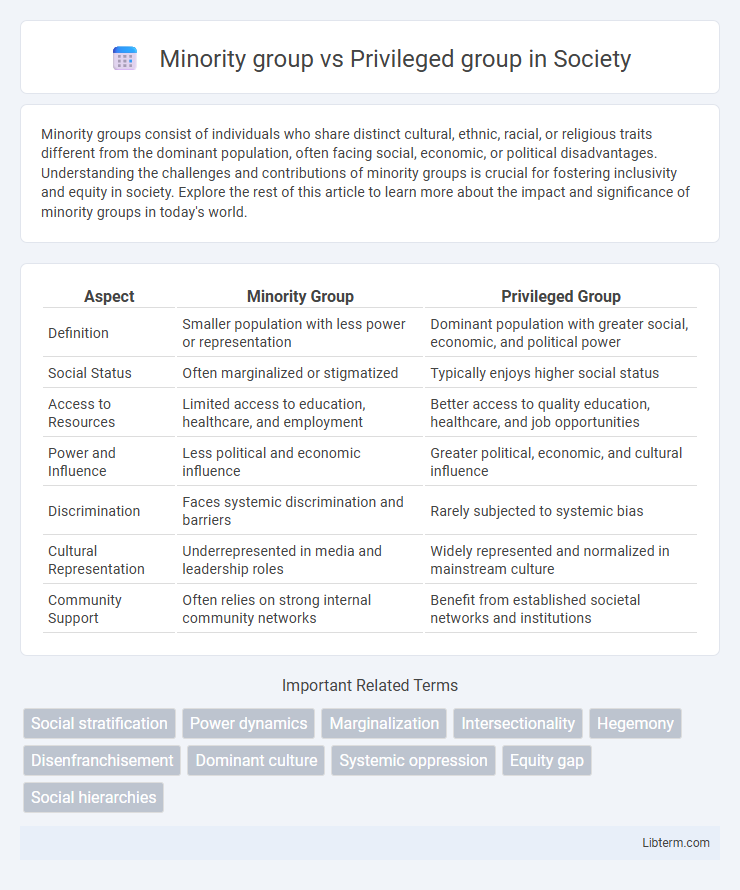Minority groups consist of individuals who share distinct cultural, ethnic, racial, or religious traits different from the dominant population, often facing social, economic, or political disadvantages. Understanding the challenges and contributions of minority groups is crucial for fostering inclusivity and equity in society. Explore the rest of this article to learn more about the impact and significance of minority groups in today's world.
Table of Comparison
| Aspect | Minority Group | Privileged Group |
|---|---|---|
| Definition | Smaller population with less power or representation | Dominant population with greater social, economic, and political power |
| Social Status | Often marginalized or stigmatized | Typically enjoys higher social status |
| Access to Resources | Limited access to education, healthcare, and employment | Better access to quality education, healthcare, and job opportunities |
| Power and Influence | Less political and economic influence | Greater political, economic, and cultural influence |
| Discrimination | Faces systemic discrimination and barriers | Rarely subjected to systemic bias |
| Cultural Representation | Underrepresented in media and leadership roles | Widely represented and normalized in mainstream culture |
| Community Support | Often relies on strong internal community networks | Benefit from established societal networks and institutions |
Defining Minority and Privileged Groups
Minority groups are defined by their limited access to power, resources, and social influence compared to the dominant population, often characterized by differences in race, ethnicity, religion, or socioeconomic status. Privileged groups hold systemic advantages in society, benefiting from greater representation, resource control, and institutional support that reinforce their superior status. Understanding these dynamics is key to addressing inequality and promoting social equity across diverse communities.
Historical Context of Social Inequality
Historical context reveals that minority groups have often faced systemic discrimination and exclusion from economic, political, and social resources, reinforcing cycles of disadvantage. Privileged groups, benefiting from entrenched power structures and access to opportunities, have historically maintained social dominance and control over wealth distribution. This dynamic has contributed to persistent social inequalities and institutionalized barriers affecting minority communities across generations.
Social Identity and Group Dynamics
Minority groups often experience social identity shaped by marginalization and limited access to resources, influencing their group dynamics through internal solidarity and resilience. Privileged groups benefit from dominant social identities that grant greater access to power, fostering dynamics characterized by norm-setting and social influence. Interactions between these groups reveal power imbalances affecting social cohesion, identity negotiation, and collective behavior patterns.
Power Structures and Privilege
Minority groups typically lack access to dominant power structures, resulting in limited social, economic, and political privileges compared to privileged groups. Privileged groups control institutional decision-making, resource distribution, and cultural norms, reinforcing systemic inequalities that maintain their dominant status. Power dynamics in society systematically afford privileged groups advantages in education, employment, and legal representation, perpetuating disparities against minority populations.
Economic Disparities Between Groups
Minority groups often face significant economic disparities compared to privileged groups, including higher unemployment rates and lower average incomes. Wealth gaps persist due to historical discrimination and limited access to quality education, housing, and financial resources. These economic inequalities contribute to persistent poverty cycles and reduced social mobility within minority communities.
Representation in Media and Culture
Minority groups often face underrepresentation or stereotypical portrayals in media and culture, limiting their visibility and reinforcing social inequalities. Privileged groups typically dominate media narratives, shaping cultural norms and influencing public perception through widespread access to production and distribution channels. Increasing diverse and accurate representation of minority groups fosters inclusivity, challenges biases, and promotes social equity in cultural discourse.
Education Access and Opportunities
Minority groups often face systemic barriers in education access, resulting in lower enrollment rates and limited opportunities for advanced coursework compared to privileged groups. Privileged groups typically benefit from greater resources, including well-funded schools, experienced teachers, and extracurricular opportunities that enhance academic achievement. These disparities contribute to achievement gaps and perpetuate social inequalities across generations.
Systemic Discrimination and Bias
Minority groups often face systemic discrimination and bias embedded in societal institutions, leading to disparities in access to resources, opportunities, and justice. Privileged groups benefit from structural advantages, including favorable representation and institutional support, which perpetuate inequality. Understanding these dynamics is essential for addressing entrenched social disparities and promoting equity.
Allyship and Advocacy for Minorities
Allyship involves actively supporting minority groups by amplifying their voices and challenging systemic inequalities embedded within privileged group dynamics. Effective advocacy requires understanding power imbalances and leveraging privilege to promote equitable access to resources and opportunities for marginalized communities. Consistent allyship fosters inclusion and social justice by holding privileged groups accountable and driving institutional change.
Building Inclusive Societies
Minority groups often face systemic disadvantages in access to education, healthcare, and employment, limiting their social and economic mobility compared to privileged groups who benefit from historical advantages and institutional support. Building inclusive societies requires proactive policies such as affirmative action, anti-discrimination laws, and representation initiatives to level the playing field and foster equity. Empowering minority communities through education, political participation, and economic opportunities promotes social cohesion and reduces inequality.
Minority group Infographic

 libterm.com
libterm.com